LG continues to experiment with its flagship handset and while we’ve already seen how they’re leaning towards as evidenced by the LG G5, their phablet counterpart is a little more subdued.
The V series is LG’s super-sized (phablet) flagship smartphone and the V20 is the second-generation handset. LG took a different approach to the V20 compared to the flagship G5 just to make sure that it’s not just about the size but also specific features that will separate them both.
 LG V20 beside LG G5
LG V20 beside LG G5
While the LG V20 did not follow the modular features of the LG G5, it certainly took some design cues from the latter.
Table of Contents
The V20 takes the same basic design signature as its predecessor, the LG V10. However, this time around, LG has employed an all-metal design rather than the rubber-clad V10. There’s some resemblance of the LG G5 in the LG V20 especially with the tapered chin and forehead. Like the V10, the LG V20 also has a removable back cover so you can replace the battery anytime you want.
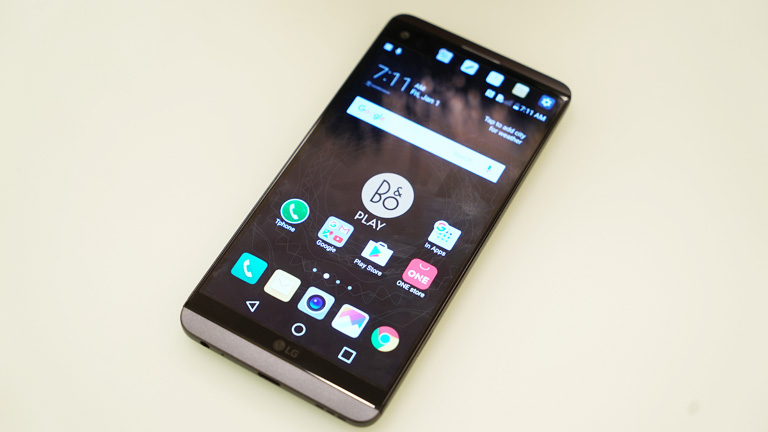
On the right side of the device is the button to release the lock for the back cover, the volume controls are on the left side. Up top is the noise-canceling mic and the IR blaster and at the bottom are the 3.5mm audio jack, USB Type-C charging port, primary microphone and speaker grill.

At the back are the dual-rear cameras with dual-LED flash and a couple of sensors that are propped up in a protruding module. Just below it is the circular fingerprint sensor and the Bang & Olufsen logo and the V20 markings. You don’t see any antenna lines because the top and bottom ends of the device are already made up of polycarbonate materials.
The front side is mostly covered with glass panel although the chin and forehead are made up of some treated polycarbonate material that mimics the aluminum finish (silicon polycarbonate to be specific, same materials used in helmets). The device is thin (7.6mm) and relatively light (174 grams) considering its size. It’s still comfortable to hold with one hand and has a good grip due to its slightly tapered back.

We like the rather smooth matte finish of the body and the coating that also absorbs colors just like Titan Black variant that gives a blue hue in the outdoors.
LG claims the V20 is a ruggedized, just like the V10, so it can withstand drops but that doesn’t mean it won’t get the usual scratches and dings if you don’t take good care of it.
One of the biggest differentiator of the LG V20 is the dual display up at the front. The main display is a 5.7-inch IPS LCD display that has a quad-HD or 2560×1440 pixel resolution. That puts the pixel density to a nice 513ppi which is one of the best in the market.

This is the same nice and crisp display we’ve seen from the V10 and the LG G5. Images are crisp and clear, screen is bright and visible in the outdoors and even relatively under direct sunlight while colors are vibrant but not over-saturated. The bezels are narrow along the sides but nothing spectacular. They’re about 2mm thick or so and just the same as in the G5.
Age-old features such as the double-tap to wake/sleep are present which is great since there are no physical buttons up front.
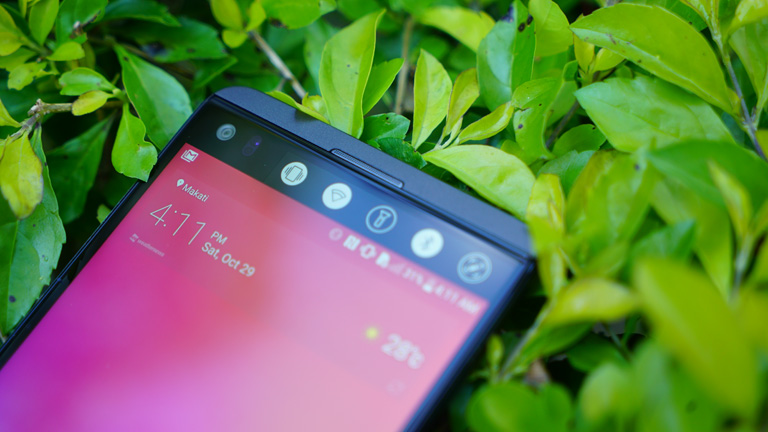
What’s particularly nice about the V20 is the secondary display just above the main screen. The display sits just beside the front-facing camera and sensors (so it’s not as wide as the main display). It is 2.1-inch across with a resolution of 160×1040 pixels. This screen can be set to be always on even if the main screen is off so you can still see some notifications in there as well as set the date and time to show constantly, thus reducing battery consumption. You can also customize the screen to some extent.
It’s a novel idea first introduced in the V10 and though you tend to forget it’s there, once you get used to screen it becomes really useful.
Camera and Multimedia.
The LG V20 comes with the same dual-rear camera setup which was originally introduced in the G5. The two cameras have different specs that addresses a lot of scenarios in terms photography.
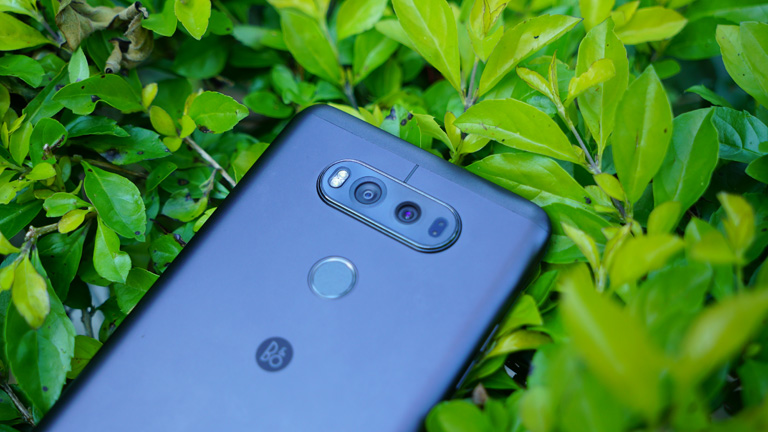
The first one is a 16MP with a large f/1.8 aperture and optical image stabilization. Its 75-degree field of view is great for regular shots like close-up or portraiture. The second camera has 8MP sensor with f/2.4 aperture and 135-degree field of view that’s perfect for taking very wide angle shots and landscape scenes. The cameras are complimented with a hybrid auto-focus system (Laser Detection AF, Phase Detection AF, Contrast AF).

There are noticeable differences in the quality of the 16MP rear camera compared to the 8MP wide-angle camera which is primarily due to the type of sensors use. The 16MP has more detail, dynamic range and much better in low-light conditions (f/1.8 vs. f/2.4). You will see this difference in the sample photos in the gallery below:
We also noticed that there’s a slight difference between the output quality of the LG G5 and the V20. We reckon this could be due to image optimizations done on the V20.
It’s also worth to note that the video recording of the V20 is enhanced using multiple microphones. This allows audio recording to reduce background noise and users are able to switch microphones to pick up more sound in the front or at the back.
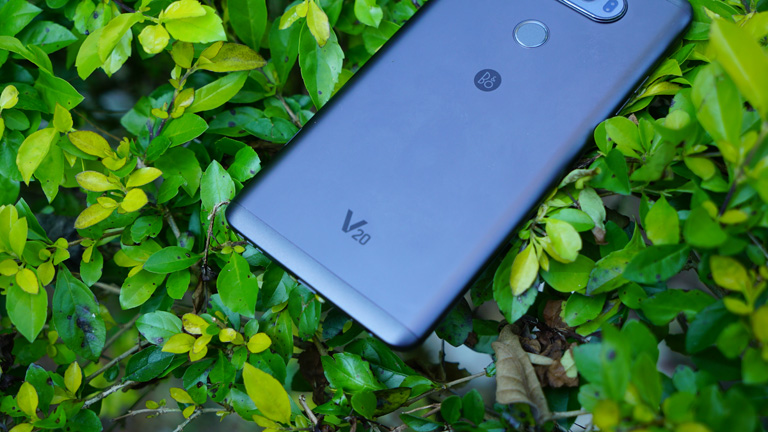
One of the most anticipated features of the LG V20 is the built-in DAC (digital-to-analog converter) which was first introduced in the V10. It’s still present in the V20 and it produces really good audio output via the headphone jack and the speakers although it can also output audio via the USB Type-C port. Those who are very particular about their music will certainly love this. With the new quad DAC and amplifier used in the V20, there should be better audio output compared to the V10.
The collaboration with Bang& Olufsen also includes a high-quality B&O earphones in the box (they come with headphones in other regions). The lone speaker at the bottom end sounded really good, has noticeable bass and very loud but doesn’t distort even at max volume.
OS, UI and Apps.
Running on Android 7.0 Nougat right out of the box, the LG V20 is the first one to have the latest Android OS in the market (followed by Google’s very own Pixel). This puts the V20 ahead of everyone else in terms of software features.
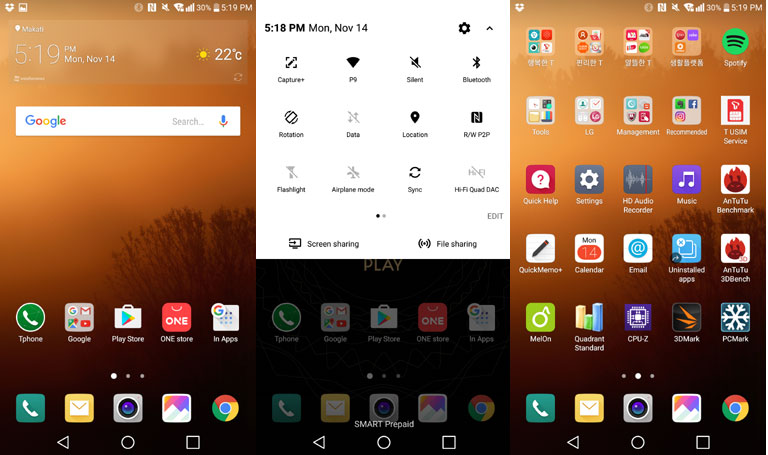
The LG UI is still there and super-imposes its own interface. The new app drawer on Android Nougat was not inherited and the V20 follows the same flat homescreen across all apps and widgets.
Our review unit is the Korean variant so it comes with a lot of pre-installed apps that aren’t that useful or relevant (we believe the PH variant will have none of these).
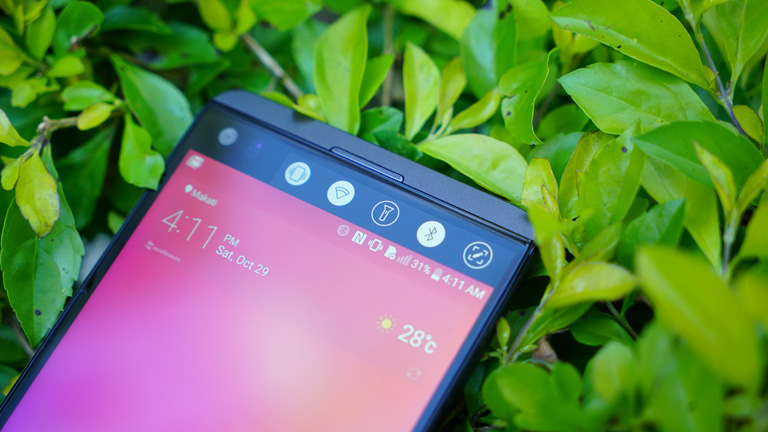
The presence of the secondary display just above the main display offers a unique interface not found in any other device (as inherited from the LG v10). This one-liner screen offers shortcuts to the most frequently accessed apps or features and serves as notification window for alerts and messages.
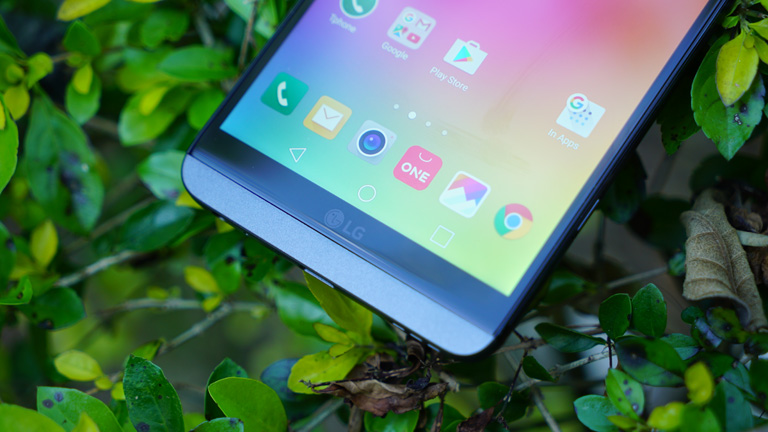
Suffice it to say, the V20 feels snappy and fluid. It’s a simple UI but you are given freedom to customize it to a certain extent. Of course, if you don’t like the LG UI, you can always pick 3rd party launchers to use. Google Assistant, the one that we tried out in the Google Pixel, is not yet available here.
Call Quality, Connectivity and Battery Life.
The V20 has all connectivity options available to the user — dual-SIM, LTE support, fast WiFi, Bluetooth, NFC, GPS and an IR blaster to boot.
Call quality is excellent — voice calls are loud and clear, SMS are sent and received quickly and signal strength for WiFi, GPS and mobile internet are good in most cases. Several LTE speed tests showed numbers hitting an average of 15Mbps.

One of the features that we really liked is the inclusion of an IR blaster, something that has become quite rare these days. You can use this as a universal remote to many of your home appliances.
For such a large smartphone, we think the 3,200mAh battery isn’t that much. Good thing it supports Quick Charge 3.0 and is also removable so you can swap it out anytime with a back-up. Nevertheless, we registered 11.5 hours in our standard video loop test at 50% brightness, zero volume and in airplane mode (Note: The PCMark Battery bench crashes before it finishes the test).
Base don our personal usage consumption, the LG V20 can handle an entire day of mixed use from the usual social media apps, web browsing and streaming on Spotify though you’ll most certainly have to re-charge it before going to sleep. With support for Quick Charge 3.0
Performance and Benchmarks.
The LG V20 comes with a powerful Snapdragon 820 chip paired with 4GB of RAM. This puts the V20 in the same league as the other flagship smartphones.

With a score of 147,389 in Antutu benchmark, the LG V20 tops the benchmark across all other Android smartphones we’ve tested this year. The high score could have been contributed by optimizations made on Android 7.0 Nougat on the LG V20.
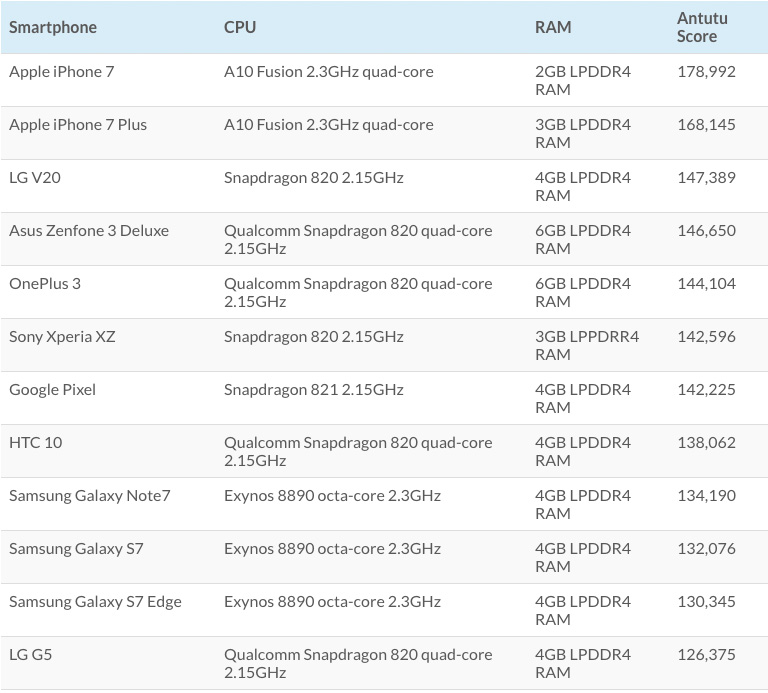
The LG V20 takes the top spot among Android smartphones we’ve tested (according to Antutu benchmarks).
Antutu Benchmark: 147,389
Quadrant Standard: 26,517
PC Mark: 6,257 (Work 1.0), 4,588 (Storage)
3D Mark: 1,832 (Slingshot ES 3.1)
Vellamo: 5,040 (Chrome), 3,429 (Metal), 2,505 (Multi-core)
Suffice it to say, the V20 is a beast in terms of performance. It practically chew up anything we threw at it — from running multiple apps to playing graphics intensive games like NBA2k17, GTA and Modern Combat.
LG’s positioning with the V20 is evident and well-received. They’ve included a number of features that will differentiate themselves from the competition, whether it’s the secondary display, the built-in DAC, the ruggedized design or as simple as sticking to the removable battery feature. It’s got specific features that will likely attract certain types of users.

The V20 is certainly a great phone in so many aspects, though not without fault. We wish it was also water-resistant but considering the removable battery, that’s already over-reaching. That goes without saying that you can’t really have them all but still, the V20 is way up there as one of your best options.
The LG V20 is now available in stores with a suggested retail price of Php35,990USD 613INR 51,991EUR 584CNY 4,466.
Author’s note: The review unit that we got is the Koran variant so there are a few differences between this one and the PH variant.
LG V20 specs:
5.7-inch QHD (2560 x 1440) IPS display, 513ppi
2.1-inch (160 x 1040) secondary display
Gorilla Glass 4
Qualcomm Snapdragon 820 2.15GHz quad-core CPU
Adreno 530 GPU
4GB LPDDR4 RAM
64GB UFS ROM
up to 2TB via microSD
16MP (f/1.8 aperture, 75-degree lens) w/ OIS + 8MP (f/2.4 aperture, 135-degree lens) rear cameras, Hybrid AF (Laser Detection AF, Phase Detection AF, Contrast AF)
5MP front camera w/ f/1.9 Aperture (120-degree lens)
LTE-A 3 Band CA
X12 LTE (up to 600 Mbps LTE Category 12 with 3x Carrier Aggregation)
WiFi 802.11ac
NFC
Bluetooth 4.2 BLE
USB Type-C
Fingerprint scanner
High AOP Mic
32-bit Hi-Fi Quad DAC
B&O Collaboration for audio
Android 7.0 Nougat w/ LG UX 5.0+
3,200mAh removable battery w/ Qualcomm Quick Charge 3.0
159.7 x 78.1 x 7.6mm (dimensions)
174 grams (weight)
Titan Black, Silver, Pink
What we liked about it:
What we did not like:
You cna also check out our video comparison between the LG V20 and the Asus Zenfone 3 Deluxe:

YugaTech.com is the largest and longest-running technology site in the Philippines. Originally established in October 2002, the site was transformed into a full-fledged technology platform in 2005.
How to transfer, withdraw money from PayPal to GCash
Prices of Starlink satellite in the Philippines
Install Google GBox to Huawei smartphones
Pag-IBIG MP2 online application
How to check PhilHealth contributions online
How to find your SIM card serial number
Globe, PLDT, Converge, Sky: Unli fiber internet plans compared
10 biggest games in the Google Play Store
LTO periodic medical exam for 10-year licenses
Netflix codes to unlock hidden TV shows, movies
Apple, Asus, Cherry Mobile, Huawei, LG, Nokia, Oppo, Samsung, Sony, Vivo, Xiaomi, Lenovo, Infinix Mobile, Pocophone, Honor, iPhone, OnePlus, Tecno, Realme, HTC, Gionee, Kata, IQ00, Redmi, Razer, CloudFone, Motorola, Panasonic, TCL, Wiko
Best Android smartphones between PHP 20,000 - 25,000
Smartphones under PHP 10,000 in the Philippines
Smartphones under PHP 12K Philippines
Best smartphones for kids under PHP 7,000
Smartphones under PHP 15,000 in the Philippines
Best Android smartphones between PHP 15,000 - 20,000
Smartphones under PHP 20,000 in the Philippines
Most affordable 5G phones in the Philippines under PHP 20K
5G smartphones in the Philippines under PHP 16K
Smartphone pricelist Philippines 2024
Smartphone pricelist Philippines 2023
Smartphone pricelist Philippines 2022
Smartphone pricelist Philippines 2021
Smartphone pricelist Philippines 2020
gschock says:
Best andriod phone you can get for 30k on online stores
Spider says:
What is the model of LG V20 in the Philippines? For example, (H918, H830 , etc…)
Kiko says:
What is philippine variant for lgv20?